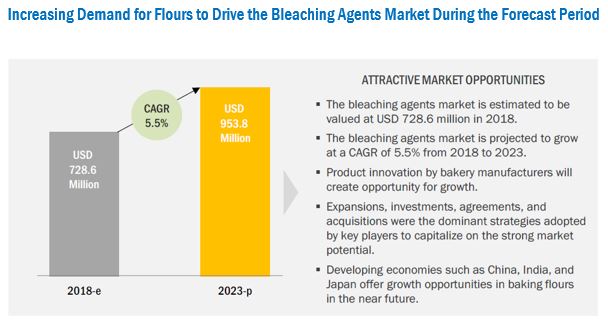The bleaching agents market is estimated at USD 728.6 Million in 2018 and is projected to reach USD 953.8 Million by 2023, growing at a CAGR of 5.5% during the forecast period. The market size of bleaching agents includes both, the valuation of existing bleaching agents and incremental revenue year-on-year. The global demand for bleaching agents is increasing significantly due to the rising demand for bread and bread-related products, growing urban population, increasing disposable income, and the technological advancements in flour quality assessment.
Based on type, the hydrogen peroxide segment is projected to hold the largest share, in terms of value, of the global market. In the food & beverage processing industry, it is commonly used as a peroxygen agent in products such as flour, bakery foods, natural sugars, natural oils, waxes, gums, and starches.

The powder segment, by form, accounted for a larger share of the global market in 2017. The powdered form of bleaching agents, which include ascorbic acid, hydrogen peroxide, and potassium bromates, has a longer shelf-life and is usually stable for many years when stored at room temperature. Furthermore, technological advancements have led to increased usage of powdered bleaching agents as the dosing is easier than the liquid form.
The flour segment, by application, accounted for the largest share of the market in 2017. Bleaching agents are used for whitening flour, as freshly milled flour has a slightly yellowish color as it contains carotenoids. Additionally, bleaching oxidizes the surface of the flour and promotes its gluten-producing potential. Bleaching of flour helps in the weakening of the proteins and maturation of the flour in a reduced amount of time and has thereby become a necessity for flour producers.
Companies such as Evonik Industries (Germany), BASF (US), Solvay (Belgium), AkzoNobel (Netherlands), and PeroxyChem (US) collectively account for a share of more than half of the bleaching agents market. These companies have a strong presence in Europe, North America, and the Rest of the World (RoW). They also have manufacturing facilities across these regions and a strong distribution network.


